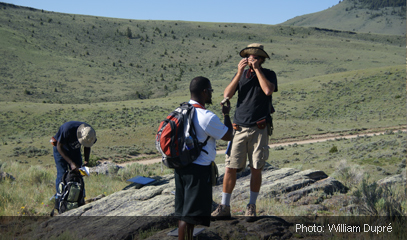
By Rolando Garcia
Natural Sciences and Mathematics
The picturesque camp at the foot of the Beartooth Mountains in Montana near Yellowstone National Park comes complete with rustic-looking cabins, kitchen and mess facilities and perfect natural scenery.
But the University of Houston geoscience students who camp there during the summer get much more than spectacular views and roasted marshmallows. Through geological mapping, rock studies, logging wells and collecting high-tech seismic measurements, students gain the hands-on experiences that are crucial to the earth sciences.
At a time when other universities are cutting back on geoscience field programs, UH’s Department of Earth & Atmospheric Science is placing a renewed emphasis on experiential learning.
And with the support of geoscience alumni and corporate sponsors at a major fundraising gala this week, the department hopes to establish a permanent endowment to continue sending students to the field camp in Montana.
The department had previously conducted geology field camps in New Mexico but in 2008 relocated to a more permanent facility when it assumed shared management of the storied summer geology program at Yellowstone-Bighorn Research Association Field Station near Red Lodge, Montana.
Located near the Beartooth Mountains, Yellowstone, the Bighorn Basin and the Grant Tetons, the 120-acre camp is an ideal setting for geological and geophysical investigations and mapping.
This move bucked the national trend among geoscience departments – the number of schools offering summer geology camps has declined by 50 percent over the last 20 years, according to the American Geological Institute. Only 15 percent of the nearly 700 geoscience departments in the institute’s directory currently offer summer field camps.
In addition to its geology camps, this past summer UH offered its first summer camp in geophysics – one of only four or five such field programs in the country, said Robert Stewart, the Hugh Roy and Lillie Cranz Cullen Distinguished Professor of Exploration Geophysics at UH.
Because it involves drilling and logging wells and using high-tech seismic instruments, geophysical camps can be costly, but are essential to teaching students how to operate seismic equipment, gather field data and undertake geophysical surveys, Stewart said.
“Studying geophysics without ever practicing it in the field is like learning how to ski without ever hitting the slopes,” said Stewart, who spearheaded the new geophysics camp.
The Oct. 24 evening gala to raise money for the field programs will also be a reunion of sorts for the UH’s geoscience alumni and corporate partners. Many will be in town for the annual meeting of the Society of Exploration Geophysicists, which begins the next day.
Proceeds will be used to establish a permanent fund to assist with operating costs and provide field camp scholarships for deserving students.
The gala will be held at Houston Museum of Natural Science and will include a cocktail reception followed by dinner.
At the dinner William A. Berggren will be presented the 2009 UH Geosciences Distinguished Alumni Award for his achievements in geology and paleontology. He earned a master’s degree from UH in 1957 and went on to get a Ph.D. at the University of Stockholm. In 1989 he was elected to the National Academy of Sciences.
He is currently a scientist emeritus at the Woods Hole Oceanographic Institution in Massachusetts and a Distinguished Visiting Professor at Rutgers University.
For more information on the event or to buy a ticket contact Tram Nguyen at 713-743-3402 or tnguye36@mail.uh.edu
The deadline is Wednesday so buy your ticket today. |

